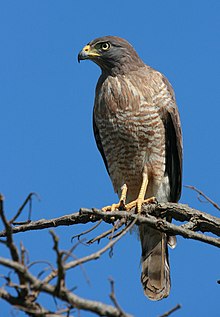Buzzards
| Buzzards | ||||||||||
|---|---|---|---|---|---|---|---|---|---|---|

Common buzzard ( Buteo buteo ) |
||||||||||
| Systematics | ||||||||||
|
||||||||||
| Scientific name | ||||||||||
| Buteo | ||||||||||
| Linnaeus , 1758 |
Buzzards ( buteo ) are medium-sized birds of prey from the hawk family.
Word origin
The name was borrowed from French (French busard = consecration, from Latin buteo = "mouse falcon", buzzard). Before that the bird was called ahd. Musari , mhd. Mus-ar, mnd. muser "Mäuseaar" = "mouse eagle".
The ancient naming "mouse falcon" [lat. buteo (Gen .: buteonis) = a falcon] is misleading because false: According to recent DNA studies include hawks systematically with its own order in the class birds no longer order of birds of prey .
description
Buzzards are broad-winged, short-tailed hoverers. In appearance they are similar to the genus Aquila (real eagles), but differ in their smaller size and other features.
The beak is comparatively short and curved from the start. Only three to four of the outer hand wings have a clear narrowing on the inner vane. The legs of the majority of the species are feathered, four species have fletching on the back. The plumage is often cross-banded on the underside.
The females are usually somewhat larger than the males, this sexual dimorphism is less pronounced than in the genus Accipiter (hawks and sparrowhawks); Color dimorphism and polymorphism are common.
With a few exceptions, buzzards are less specialized hunters of small mammals (especially mice) and birds. But buzzards also eat earthworms , insects , reptiles and carrion .
They almost always hit their prey on the ground. Either they pounce on them from a hide, or they go from gliding (in which they use thermals like gliders ) and short jolting flight (in the case of buzzards and buzzards) into diving.
Systematics and distribution
The genus of the real buzzards ( Buteo ) comprises 29 species , but the recognition of some subspecies as an independent species is the subject of scientific discussions.
With the exception of the Australis , the genus is distributed worldwide, the greatest species diversity is in the Neotropis .
Only two species of this genus breed in Central Europe : the common buzzard ( Buteo buteo ) and the eagle buzzard ( Buteo rufinus ). The northern northern buzzard ( Buteo lagopus ) appears regularly as a winter visitor; the honey buzzard is not a member of the genus Buteo , but belongs to the genus Pernis .
species
- Eagle Buzzard ( Buteo rufinus )
- Andean buzzard ( Buteo ventralis )
- Archer buzzard ( Buteo archeri )
- Augur Buzzard ( Buteo augur )
- Ribbon-tailed buzzard ( Buteo albonotatus )
- Mountain Buzzard ( Buteo oreophilus )
- Broad-winged buzzard ( Buteo platypterus ) or broad- winged buzzard
- Galapagos Buzzard ( Buteo galapagoënsis )
- Gray buzzard ( Buteo plagiatus )
- Haiti Buzzard ( Buteo ridgwayi )
- Hawaiian buzzard ( Buteo solitarius )
- Himalayan buzzard ( Buteo refectus )
- Highland buzzard ( Buteo hemilasius )
- King Buzzard ( Buteo regalis )
- Short-tailed buzzard ( Buteo brachyurus )
- Madagascar buzzard ( Buteo brachypterus )
- Common buzzard ( Buteo buteo )
- Common buzzard ( Buteo swainsoni )
- Buzzard ( Buteo lagopus )
- Red-backed Buzzard ( Buteo polyosoma )
- Red-shouldered buzzard ( Buteo lineatus )
- Red-tailed buzzard ( Buteo jamaicensis )
- Schakal Bussard ( Buteo rufofuscus )
- Socotra buzzard ( Buteo socotraensis )
- Mutable buzzard ( Buteo poecilochrous )
- Common buzzard ( Buteo magnirostris )
- White-winged Buzzard ( Buteo leucorrhous )
- European white-throated buzzard ( Buteo albigula )
- Buzzard ( Buteo nitidus )
Super species
The Common Buzzard, Eagle Buzzard, Highland Buzzard, Mountain Buzzard and Madagascar Buzzard together form a super species .
literature
- Theodor Mebs : European birds of prey - biology - population conditions - population endangerment . Franckh-Kosmos Verlag, Stuttgart 2002, ISBN 3-440-06838-2
- Urs N. Glutz von Blotzheim , Kurt M. Bauer and E. Bezzel: Handbook of the birds of Central Europe. Volume 4, Akademische Verlagsgesellschaft, Frankfurt am Main 1971, ISBN 3-400-00069-8 .
Web links
Individual evidence
- ↑ Duden (2007): The dictionary of origin. Mannheim, "Buzzard"
- ↑ Duden (2001): The dictionary of origin. Mannheim, "Buzzard"
- ↑ Duden (2006): German Universal Dictionary. Mannheim, "Buzzard"
- ^ Duden (2007): The great foreign dictionary. Mannheim, "Buzzard"
- ^ J. Ferguson-Lees, DA Christie (2001): Raptors of the World. London: Helm Edt.
- ↑ a b L. Kruckenhauser, E. Haring, W. Pinsker, MJ Riesing, H. Winkler, M. Wink, A. Gamauf (2004): Genetic vs. morphological differentiation of Old World buzzards. (genus Buteo, Accipitridae). Zoologica Scripta , 33, pp. 197-211

